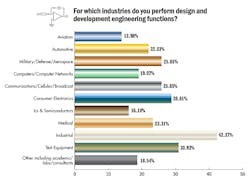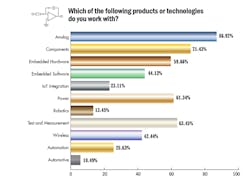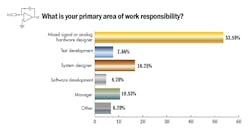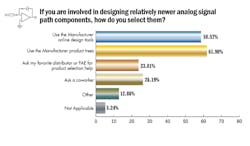What are Analog Signal-Path Design Engineers Up To?
Members can download this article in PDF format.
What you’ll learn:
- The current state of engineers working in analog signal-path engineering.
- Who they are, their ages, experience, and their time in the practice.
Signal-path design refers to the process of designing the route or path that a signal (such as an electrical or optical signal) takes as it travels through a system or device. This includes the selection of components and their configuration, as well as the optimization of the signal path to meet specific performance requirements. The signal-path design process also includes factors such as signal integrity, noise, and signal loss.
A signal-path design engineer is a professional who designs and optimizes the route or path a signal takes as it travels through a system or device. Engineers within this field also may work with a variety of signal types, such as electrical, optical, and wireless signals. They may be involved in the design of a wide range of systems and devices, including communication systems, electronic devices, and medical equipment.
Furthermore, engineers in this field must have a good understanding of signal processing, electronics, and communication systems, in addition to knowledge of signal integrity, noise, and signal loss. On top of that, the engineer should be proficient in using various simulation tools and software packages to design and optimize signal paths.
Survey Says…
With that said, our recent Electronic Design survey paints signal-path design engineers by the numbers, with metrics that encompass everything from primary job functions to circuit types. The information provides a detailed overview of engineers working within the analog signal-path design field and what the future might hold for both new and veteran engineers.
Analog signal-path design is a specialized field within electrical engineering and typically requires a solid knowledge of circuit design and analysis and experience with analog components and systems. It’s a relatively small field, as many designs are now digital.
The number and ages of actual engineers within this field from a global perspective are currently unknown. Though if we consider that the analog signal-path design is a subset of the electrical engineering field, the U.S. Bureau of Labor Statistics Occupational Outlook Handbook provides some less-than-stellar numbers.
Overall employment of electrical and electronics engineers is projected to grow 3% from 2021 to 2031, slower than the average for all occupations. Despite that limited growth, about 20,100 openings for electrical and electronics engineers are projected each year, on average, over the decade. Most of those openings are expected to result from the need to replace workers who transfer to different occupations or exit the labor force, including retiring.
More Specifics in Job Functionalities
Analog signal-path design engineers often specialize in specific job roles depending on company requirements and needs that arise within a project scope (Fig. 1). Some are tasked with R&D, designing ICs from the beginning to end of a project lifecycle. Others can take on the mantle of management based on education and training, job history, and qualifications throughout their careers.
Most engineers in the field are involved with the design element, creating circuits and systems that are used to process signals in various applications, such as telecommunications, audio processing, and instrumentation.
Their role is to determine the best way to transmit signals from one place to another with minimal loss and interference. This requires a deep understanding of electrical theory, circuit design, and the properties of different components, as well as a mastery of specialized design tools and simulation software.
The goal of an analog signal-path design engineer is to create efficient and effective signal-processing systems that meet the needs of the particular application, whether it’s for consumer electronics, medical devices, or aerospace systems.
The most significant percentage of engineers have been in the industry for 40 years or more while dealing with the design element (Fig. 2). And because few new engineers are entering the field, it could have an impact on legacy designs that may be lost as veterans retire.
Over 41% of those engineers work in an industrial environment, such as those in aerospace, automotive, medical, and defense (Fig. 3). Job functions in this area can include designing and implementing analog signal-processing systems for industrial control systems, testing analog circuits for industrial sensors, and integrating analog signal-conditioning circuits. Others are tasked with designing test equipment, consumer electronics, and communications systems.
No matter the industry, the highest percentage of analog signal-path design engineers today take advantage of a variety of component technologies through the design process for any number of applications (Fig. 4). Some of the most commonly used analog technologies in signal-path design include operational amplifiers (op amps), comparators, and voltage regulators. Designs may require filters to remove unwanted frequency components from a signal, or to isolate a particular frequency band.
Engineers also can take advantage of analog-to-digital converters (ADCs), digital-to-analog converters (DACs), AM and FM circuits to modulate carrier signals, and conditioning ICs to refine signals for further processing (Fig. 5). These are just some of the many analog technologies commonly used by signal-path design engineers in their projects, which is often done two or more times per month.
Responsibilities
Of course, designs are regulated based on the area of work responsibility. According to the survey, engineers are tasked to design mixed signals and analog hardware every couple of months, followed by system designs and software development (Fig. 6).
This involves selecting suitable components and circuit designs and requires a comprehensive understanding of the signal-processing requirements, as well as a good understanding of the properties and limitations of various components. Component selection for those designs is usually dictated by the requirements and circuit topology, as well as voltage requirements, thermal characteristics, and other defining factors.
Most engineers in the industry are currently involved with analog signal-path design, the bread and butter within the field, and they’re aware of the latest components and design elements from manufacturers (Fig. 7). This is often done via updated manufacturer product catalogs, vendor websites, subject-matter experts, and the latest press releases, which helps maintain awareness of current technologies as they become available.
Moreover, the highest percentage of engineers typically use manufacturers’ product trees and myriad online design tools to develop analog signal-path components (Fig. 8). Some of the most commonly used tools include circuit design and simulation software, component selectors and datasheets, technical reference libraries, online component distributors, and others. The right tool will depend on the specific requirements of the project and the resources available.
Conclusion
Analog signal-path engineers are essential in every industry. As shown in survey results, the number of analog engineers is dwindling. With few newer, younger engineers taking over those roles as others retire, a major crisis could cripple this venerable practice.









